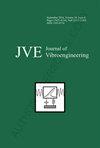Seismic performance of soft rock tunnel under composite support conditions
IF 0.7
Q4 ENGINEERING, MECHANICAL
引用次数: 0
Abstract
In order to effectively improve the seismic and impact resistance performance of soft rock tunnels, a composite support method was proposed and validated in the paper. The UDEC (Universal Distinct Element Code) model of soft rock layers was established, and the movement and subsidence characteristics of the roof and floor of the rock layers under impact loads was simulated and calculated. As a result, a composite support scheme with good cushioning performance was proposed. The top and sides of the tunnel were supported by a combination of anchor rods of different lengths and metal mesh, reinforced by steel beams and vibration absorbing filler around. The anchor rod was designed as a segmented loading structure, and can be set to different preloading forces based on the internal deformation of the rock layer. The dynamic response testing scheme was designed, and the results indicate that the segmented loading anchor rod has a significant buffering effect on the response to impact load, and can provide reasonable tension feedback at different stages. Research has found that when the water cement ratio is 0.5-1.5, the curing efficiency and strength are both higher. In order to compare the seismic performance of composite support and traditional constant resistance anchor rod support, local blasting experiments were conducted. Based on a blasting vibration tester, a data detection and transmission system were designed to obtain the vibration speed of the tunnel roof during the vibration process. The research results show that composite support can reduce the maximum vibration by more than 40 %, stabilize the fragmentation coefficient at 1.38, and have a very significant vibration reduction effect.复合支护条件下软岩隧道的抗震性能
为了有效提高软岩隧道的抗震和抗冲击性能,本文提出并验证了一种复合支护方法。建立了软岩层的 UDEC(Universal Distinct Element Code)模型,模拟计算了岩层顶板和底板在冲击荷载作用下的运动和沉降特性。因此,提出了具有良好缓冲性能的复合支撑方案。隧道顶部和侧面由不同长度的锚杆和金属网组合支撑,周围用钢梁和减震填充物加固。锚杆设计为分段加载结构,可根据岩层内部变形情况设置不同的预紧力。设计了动态响应测试方案,结果表明分段加载锚杆对冲击荷载的响应具有显著的缓冲作用,并能在不同阶段提供合理的拉力反馈。研究发现,当水胶比为 0.5-1.5 时,固化效率和强度均较高。为了比较复合材料支护与传统恒阻锚杆支护的抗震性能,进行了局部爆破实验。在爆破振动测试仪的基础上,设计了数据检测和传输系统,以获取振动过程中隧道顶板的振动速度。研究结果表明,复合支护可使最大振动降低 40% 以上,破碎系数稳定在 1.38,减振效果非常显著。
本文章由计算机程序翻译,如有差异,请以英文原文为准。
求助全文
约1分钟内获得全文
求助全文
来源期刊

Journal of Vibroengineering
工程技术-工程:机械
CiteScore
1.70
自引率
0.00%
发文量
97
审稿时长
4.5 months
期刊介绍:
Journal of VIBROENGINEERING (JVE) ISSN 1392-8716 is a prestigious peer reviewed International Journal specializing in theoretical and practical aspects of Vibration Engineering. It is indexed in ESCI and other major databases. Published every 1.5 months (8 times yearly), the journal attracts attention from the International Engineering Community.
 求助内容:
求助内容: 应助结果提醒方式:
应助结果提醒方式:


